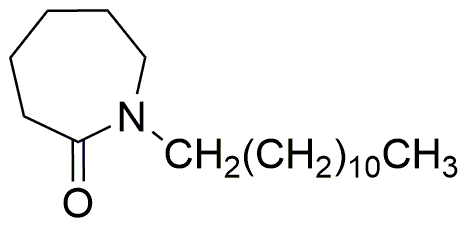Laurocapram is widely utilized in research focused on:
- Pharmaceutical Formulations: This compound acts as a penetration enhancer in drug delivery systems, improving the absorption of medications through biological membranes. Its ability to facilitate the transport of drugs makes it valuable in developing topical and transdermal therapies.
- Cosmetic Products: Due to its skin-friendly properties, laurocapram is incorporated into various cosmetic formulations. It helps improve the texture and absorption of creams and lotions, providing enhanced hydration and skin feel.
- Biotechnology: In the field of biotechnology, laurocapram is used to enhance the solubility of poorly soluble compounds, aiding in the formulation of effective biopharmaceuticals and improving their bioavailability.
- Research Applications: Researchers utilize laurocapram in studies involving drug delivery mechanisms and skin permeability, allowing for better understanding and development of new therapeutic strategies.
- Veterinary Medicine: The compound is also applied in veterinary formulations, where it helps improve the delivery of medications in animals, ensuring effective treatment and care.
General Information
Properties
Safety and Regulations
Applications
Laurocapram is widely utilized in research focused on:
- Pharmaceutical Formulations: This compound acts as a penetration enhancer in drug delivery systems, improving the absorption of medications through biological membranes. Its ability to facilitate the transport of drugs makes it valuable in developing topical and transdermal therapies.
- Cosmetic Products: Due to its skin-friendly properties, laurocapram is incorporated into various cosmetic formulations. It helps improve the texture and absorption of creams and lotions, providing enhanced hydration and skin feel.
- Biotechnology: In the field of biotechnology, laurocapram is used to enhance the solubility of poorly soluble compounds, aiding in the formulation of effective biopharmaceuticals and improving their bioavailability.
- Research Applications: Researchers utilize laurocapram in studies involving drug delivery mechanisms and skin permeability, allowing for better understanding and development of new therapeutic strategies.
- Veterinary Medicine: The compound is also applied in veterinary formulations, where it helps improve the delivery of medications in animals, ensuring effective treatment and care.
Documents
Safety Data Sheets (SDS)
The SDS provides comprehensive safety information on handling, storage, and disposal of the product.
Product Specification (PS)
The PS provides a comprehensive breakdown of the product’s properties, including chemical composition, physical state, purity, and storage requirements. It also details acceptable quality ranges and the product's intended applications.
Certificates of Analysis (COA)
Search for Certificates of Analysis (COA) by entering the products Lot Number. Lot and Batch Numbers can be found on a product’s label following the words ‘Lot’ or ‘Batch’.
*Catalog Number
*Lot Number
Certificates Of Origin (COO)
This COO confirms the country where the product was manufactured, and also details the materials and components used in it and whether it is derived from natural, synthetic, or other specific sources. This certificate may be required for customs, trade, and regulatory compliance.
*Catalog Number
*Lot Number
Safety Data Sheets (SDS)
The SDS provides comprehensive safety information on handling, storage, and disposal of the product.
DownloadProduct Specification (PS)
The PS provides a comprehensive breakdown of the product’s properties, including chemical composition, physical state, purity, and storage requirements. It also details acceptable quality ranges and the product's intended applications.
DownloadCertificates of Analysis (COA)
Search for Certificates of Analysis (COA) by entering the products Lot Number. Lot and Batch Numbers can be found on a product’s label following the words ‘Lot’ or ‘Batch’.
*Catalog Number
*Lot Number
Certificates Of Origin (COO)
This COO confirms the country where the product was manufactured, and also details the materials and components used in it and whether it is derived from natural, synthetic, or other specific sources. This certificate may be required for customs, trade, and regulatory compliance.


